 始めに、去年の熊手をここに投げています。そこ大きい熊手は高かったそうです。 Last year’s rake must have cost hundreds, if not thousands of dollars. That’s the price of good luck.
始めに、去年の熊手をここに投げています。そこ大きい熊手は高かったそうです。 Last year’s rake must have cost hundreds, if not thousands of dollars. That’s the price of good luck. 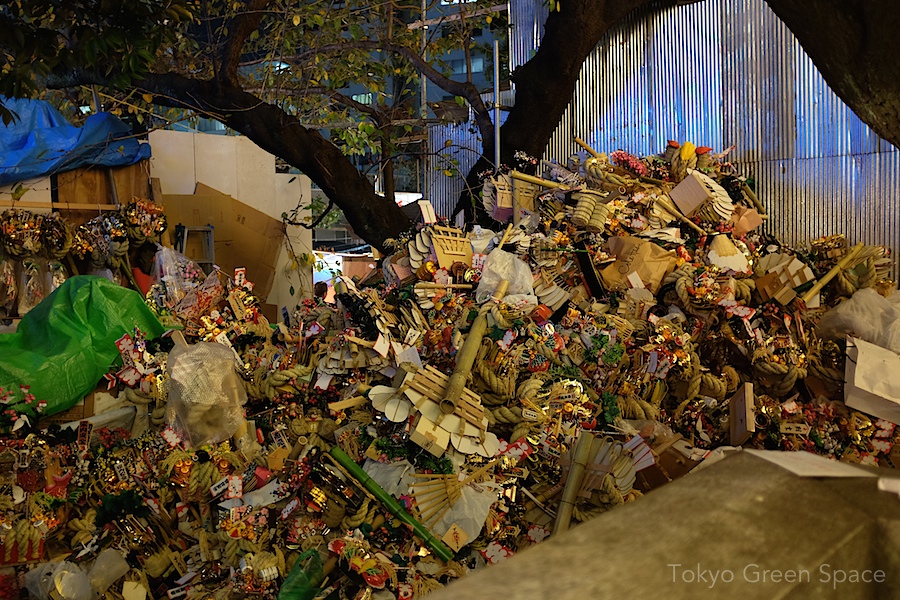

Like all of Tokyo, the Nodai campus seems to be in a state of constant demolition and reconstruction. I like how they have preserved this old grove of tall trees that remind you that this Agricultural school has a one hundred plus year history as a center of innovation and learning.

Near our apartment is this older house with a deciduous tree that fills out in the summer. I love the bunches of light green pods it produces. Sadly there are not enough old houses or old trees in Tokyo. When you see this combination in Tokyo, it’s at once nostalgic and perhaps futuristic.
Ever resourceful Jason at Flora Grubb Gardens identified it by photo as a Firmiana simplex, Chinese parasol tree in English or aogiri (アオギリ) in Japanese. A quick visit to Wikipedia taught me that it’s an ornamental tree related to cacao. It’s within the same plant family as cotton, okra, hibiscus, and abutilon.
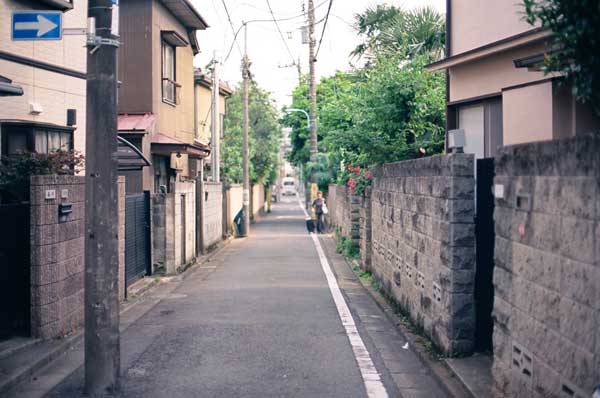
I found this lane when biking home from Koenji. I felt like I was in a small town, many decades ago.


I love walking by this wood house in Suginami. It’s a relic of an earlier time: a large wooden house, mixing Western and Japanese architectural elements, and a large garden. Seeing a remnant from the past makes it easier to imagine what this area once looked and felt like. I’d like to sleep under these huge, old trees.

三度目に芝浦に行ったとき、きれいな水に近づける運河を見つけました。道路と水の間を歩けます。地下に、小さな古い運河の出口も見つけました。
On my third trip to Shibaura, I discovered that there is one canal that provides wonderful, up-close access to water. It’s the first canal when entering from the JR Yamanote station. There’s even paths below the bridges and just above the water. On a drizzly afternoon, it was magical to be below the roadway.
Most of Tokyo’s rivers are buried, and the few remaining ones, including much of the Kanda and Zenpukuji rivers, are channeled 10 meters below street level to manage flooding. Sometimes I hear ducks echoing in these canyons, but the distance between people and water is a missed opportunity.
At the Shibaura canal, I found a tiny canal opening that seems to do pre-date the more recent developments. I like the old stones at the entrance. All that’s missing from this canal is space to get your feet wet, or even go in for a swim.


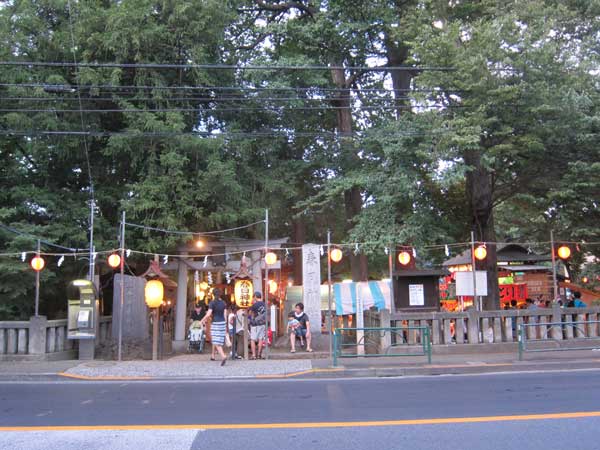
西東京の9月の祭りは、旧街道の住民を繋げます。御神輿やお盆踊りや神社の祭りは地元の神を見えるようにします。秋の祭りも町の人々に農業の周期を思い出させます。音楽や衣装や銀賞や踊りが大好きです。特別の料理、提灯、お年寄りや高校生が集まって、普通の公共空間が生き生きとしてきます。
One of my favorite times in Tokyo are the September festivals, with portable shrine carrying and yukata-clad dancing happening in small groups up and down the main roads that pre-date the west-bound Marunouchi subway and Chuo train line. These photos are from Ome Kaido and Itsukaiichi Kaido.
The fall festivals connect city life with agrarian traditions, and by bringing the shrines into the road they literally bring the local spirits into view. I like the music, the costumes, chanting and dancing. But also the festival food stalls, lanterns, and crowds of seniors and high schoolers.



高円寺ルックという商店街の、フランス風の家庭用品の店は二階に庭を作っています。植木鉢は長くて深いので、植物の種類は多いです。このきれいな庭は、すでにあるものをさらに良く見せています。この商店街は古いものと新しいものを組み合わせることに成功しています。
On my favorite Koenji shopping street called “Look,” a shop selling feminine French homewares just built a lush second floor garden. By attaching two long and deep planters, they have transformed this older building with new life. I love the variety of plants, and the way the garden adds onto what is already there.
The shop is called Malto and they are online, too.

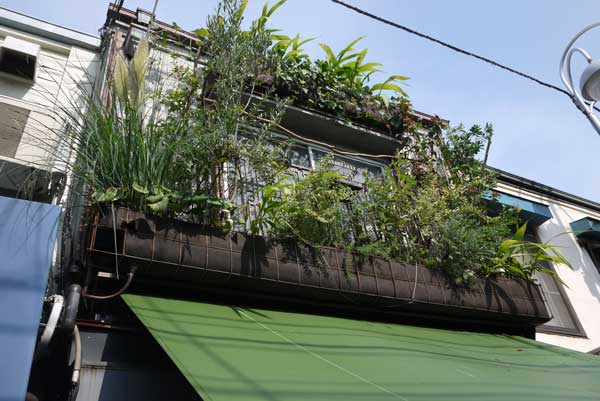

Minimal and superb Omotesando Koffee is a modular cube inside an old Omotesando house. It’s supposed to last one year, after which the building may be “reformed” as the Japanese call it.
In addition to delicious coffee in a nearly hidden spot, Omotesando Koffee has the most perfect Japanese garden with two benches for seating. I love the stone path, old light fixtures, and the very Tokyo odd mix of wood, bamboo, and the ubiquitous cinder block.
It’s a very small garden, with many traditional and resilient Japanese plants, including hollyhock, maple, and hydrangea. Worth finding if you’re in the area. Hollyhock is becoming my favorite late summer flower.
For those far away, I have included an image of the sign outside (it looks like a black frame), and the clever way they turn standard paper bags into a lovely and minimal branded object.
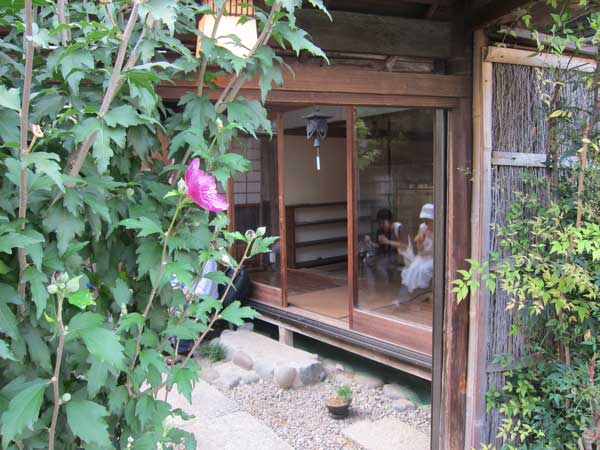


この吉祥寺の神社の木陰と静けさはとても良い雰囲気です。武蔵野八幡宮という神社は大きくて、木がたくさんあります。神社の前は五日市街道という古い道路です。この道路は新宿と西の街をつなげます。百年前、武蔵野や中野は農園だけでした。
I love this large shrine and wooded grounds in Kichijoji. Towards the end of a summer afternoon, the shadows and quiet are very inviting. The shrine is called Musashino Hachimangu (武蔵野八幡宮), and it’s on an old street that connects Shinjuku with the (now) inner western suburbs called Itsukaichi Kaido (五日市街道). A hundred years ago, Musashino and Nakano were farms, and you can see the kanji for “field” in both of these town names.

セブン・イレブンがすばやく電球を変えています。節電のために、LEDは大切です。百万人以上が新しい照明を見ることができるでしょう。この近所の店では、施工中なのに、店舗は営業しています。LEDのほうがきれいだと思いますか?
It’s very impressive how quickly 7-Eleven can install new lighting. LEDs are a huge shift in lighting, and this very prominent example will influence millions of consumers.
Many companies have agreed to large energy reductions, up to 20 and 25 percent. I noticed this van outside my local 7-Eleven yesterday. They changed the store’s lighting to LEDs without closing the business. Another store I passed yesterday in western Tokyo was also updated. I wonder how soon all the 7-Elevens will be using these very low energy lights.
I think the new strips of small lights produce a more pleasant light than the old fluorescent tubes. What do you think?

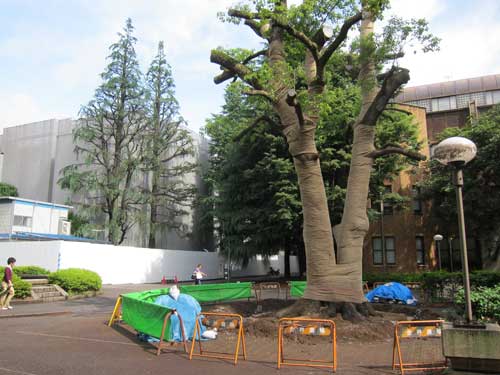
東大法学大学院の新しい図書館ができるまで、成熟したイチョウの木を移動しています。 東大は木の価値に気がついていて、うれしいです。本郷のキャンパスの背の高い木や三四郎池はとてもすてきです。
It’s wonderful to see how the University of Tokyo is carefully removing two mature ginko trees as it breaks ground for a new law school library. The Hongo campus is gorgeous, both for its brick buildings that are vaguely ivy league and art deco, but also for its stunning trees and Sanshiro pond.
The frantic pace of construction and reconstruction has left Tokyo with an inadequate tree canopy. It’s great that these two trees will survive the new building, and that the University of Tokyo demonstrates that it values its natural environment.

Another garden I saw from my bike in central Tokyo is this huge balcony garden on top of what looks like a semi-abandonded ten story building. The windows below the garden are either covered up, dirty, or reveal stacks of boxes. I wonder if the building is mixed use, and how such a large and well established garden ended up there. The Jingumae neighborhood is one of central Tokyo’s most expensive areas.
I often notice that the most intriguing and wild green spaces grow next to older buildings. It’s interesting to see the same phenomenon on an aging high-rise.